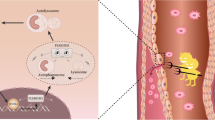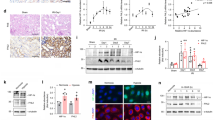Abstract
Venous hypoxia is considered as the major pathogenetic mechanism linking blood flow stagnancy with deep vein thrombosis (DVT). Our previous study showed that activating SIRT1 may attenuate inferior vena cava (IVC) stenosis-induced DVT in rats. This study was aimed to investigate the role of endothelial SIRT1 in DVT and hypoxia-induced endothelial dysfunction as well as the underlying mechanism. Protein profiling of IVCs and blood plasma of DVT rats induced by IVC stenosis was analysed by 4D Label free proteomics analysis. To verify the independent role of SIRT1 in DVT and oxygen–glucose deprivation (OGD)-induced endothelial dysfunction, SIRT1 specific activator SRT1720 and SIRT1 knockdown in both local IVCs and endothelial cells were employed. Moreover, the role of the NF-κB were investigated using NF-κB inhibitor caffeic acid phenethyl ester (CAPE). SRT1720 significantly inhibited thrombus burden, leukocytes infiltration, protein expressions of cell adhesion molecules and chemokines, as well as acetylation level of NF-κB/p65 in wild DVT rats, while these protective effects of SRT1720 were abolished in rats with SIRT1 knockdown in local IVCs. In vitro, SRT1720 protected endothelial cells against OGD-induced dysfunction characterized with enhanced adhesion of monocytes as well as the protein expressions of cell adhesion molecules and chemokines, whereas these protective effects of SRT1720 were vanished by SIRT1 stable knockdown. Furthermore, CAPE attenuated endothelial cell dysfunction and abolished these effects of SIRT1 knockdown. Collectively, these data suggested that endothelial SIRT1 plays an independent role in ameliorating hypoxia-induced endothelial dysfunction and thrombotic inflammation in DVT, and this effect is mediated by NF-κB deacetylation.






Similar content being viewed by others
Data Availability
The data that support the findings of this study are available from the corresponding author upon reasonable request.
Abbreviations
- Ace-p65:
-
Acetylated-NF-κB p65
- CAPE:
-
Caffeic acid phenethyl ester
- DVT:
-
Deep vein thrombosis
- Foxo:
-
Forkhead box class
- ICAM-1:
-
Intercellular cell adhesion molecule-1
- IVC:
-
Inferior vena cava
- MCP-1:
-
Monocyte chemotactic protein 1
- NF-κB:
-
Nuclear factor kappa B
- NC:
-
Negative control
- OGD:
-
Oxygen-glucose deprivation
- p-p65:
-
Phosphorylated-NF-κB p65
- SIRT1:
-
Sirtuin 1
- shRNA:
-
Short hairpin RNA
- VCAM-1:
-
Vascular cell adhesion molecule-1
- WT:
-
Wild type
References
Di Nisio, M., N. van Es, and H.R. Büller. 2016. Deep vein thrombosis and pulmonary embolism. Lancet 388(10063): 3060–3073. https://doi.org/10.1016/S0140-6736(16)30514-1.
Wolberg, A.S., F.R. Rosendaal, J.I. Weitz, et al. 2015. Venous thrombosis. Nature Reviews Disease Primers 1: 15006. https://doi.org/10.1038/nrdp.2015.6.
Warlow, C., D. Ogston, and A.S. Douglas. 1976. Deep venous thrombosis of the legs after strokes: Part 2-Natural history. British Medical Journal 1(6019): 1181–1183. https://doi.org/10.1136/bmj.1.6019.1181.
Sevitt, S. 1974. The structure and growth of valve-pocket thrombi in femoral veins. Journal of Clinical Pathology 27(5): 517–528. https://doi.org/10.1136/jcp.27.7.517.
Bovill, E.G., and A. van der Vliet. 2011. Venous valvular stasis-associated hypoxia and thrombosis: What is the link? Annual Review of Physiology 73: 527–545. https://doi.org/10.1146/annurev-physiol-012110-142305.
Pinsky, D.J., Y. Naka, H. Liao, et al. 1996. Hypoxia-induced exocytosis of endothelial cell Weibel-Palade bodies. A mechanism for rapid neutrophil recruitment after cardiac preservation. The Journal of Clinical Investigation 97(2): 493–500. https://doi.org/10.1172/JCI118440.
Budnik, I., and A. Brill. 2018. Immune factors in deep vein thrombosis initiation. Trends in Immunology 39(8): 610–623. https://doi.org/10.1016/j.it.2018.04.010.
Meng, X., J. Tan, M. Li, et al. 2017. Sirt1: Role under the condition of ischemia/hypoxia. Cellular and Molecular Neurobiology 37(1): 17–28. https://doi.org/10.1007/s10571-016-0355-2.
D’Onofrio, N., L. Servillo, and M.L. Balestrieri. 2018. SIRT1 and SIRT6 signaling pathways in cardiovascular disease protection. Antioxidants & Redox Signaling 28(8): 711–732. https://doi.org/10.1089/ars.2017.7178.
Ministrini, S., Y.M. Puspitasari, G. Beer, et al. 2021. Sirtuin 1 in endothelial dysfunction and cardiovascular aging. Frontiers in Physiology 12: 733696. https://doi.org/10.3389/fphys.2021.733696
Yao, X., W. Chen, J. Liu, et al. 2019. Deep vein thrombosis is modulated by inflammation regulated via Sirtuin 1/NF-κB signalling pathway in a rat model. Thrombosis and Haemostasis 119(3): 421–430. https://doi.org/10.1055/s-0038-1676987.
Henke, P.K., L.A. DeBrunye, R.M. Strieter, et al. 2000. Viral IL-10 gene transfer decreases inflammation and cell adhesion molecule expression in a rat model of venous thrombosis. The Journal of Immunology 164(4): 2131–2141. https://doi.org/10.4049/jimmunol.164.4.2131.
Zhang, X., R. Zheng, C. Liang, et al. 2022. Loss-of-function mutations in CEP78 cause male infertility in humans and mice. Science Advances 8:(40) eabn0968. https://doi.org/10.1126/sciadv.abn0968
Lu, Z., Ye, Y., Liu, Y., et al. 2021. Aqueous extract of Paeoniae Radix Rubra prevents deep vein thrombosis by ameliorating inflammation through inhibiting GSK3β activity. Phytomedicine 92: 153767. https://doi.org/10.1016/j.phymed.2021.153767
Tang, P., H. Liu, B. Lin, et al. 2020. Spatholobi Caulis dispensing granule reduces deep vein thrombus burden through antiinflammation via SIRT1 and Nrf2. Phytomedicine 77: 153285. https://doi.org/10.1016/j.phymed.2020.153285
Poredos, P., and M.K. Jezovnik. 2018. Endothelial dysfunction and venous thrombosis. Angiology 69(7): 564–567. https://doi.org/10.1177/0003319717732238.
Branchford, B.R., and S.L. Carpenter. 2018. The role of inflammation in venous thromboembolism. Frontiers in Pediatrics 6: 142. https://doi.org/10.3389/fped.2018.00142.
DeRoo, E., T. Zhou, H. Yang, et al. 2023. A vein wall cell atlas of murine venous thrombosis determined by single-cell RNA sequencing. Communiations Biology 6(1): 130. https://doi.org/10.1038/s42003-023-04492-z.
Flores-Nascimento, M.C., A.F. Paes-Leme, B.M. Mazetto, et al. 2012. Inflammatory, immune and lipid transportation proteins are differentially expressed in spontaneous and proximal deep vein thrombosis patients. Thrombosis Research 130(5): e246–e250. https://doi.org/10.1016/j.thromres.2012.08.306.
Memon, A.A., K. Sundquist, M. PirouziFard, et al. 2018. Identification of novel diagnostic biomarkers for deep venous thrombosis. British Journal of Haematology 181(3): 378–385. https://doi.org/10.1111/bjh.15206.
Ten Cate, V., J.H. Prochaska, A. Schulz, et al. 2021. Protein expression profiling suggests relevance of noncanonical pathways in isolated pulmonary embolism. Blood 137(19): 2681–2693. https://doi.org/10.1182/blood.2019004571.
Liu, H., P. Li, J. Lin, et al. 2019. Danhong Huayu Koufuye prevents venous thrombosis through antiinflammation via Sirtuin 1/NF-κB signaling pathway. Journal of Ethnopharmacology 241: 111975. https://doi.org/10.1016/j.jep.2019.111975
Wu, C., X. Li, H. Zhao, et al. 2023. Resistance exercise promotes the resolution and recanalization of deep venous thrombosis in a mouse model via SIRT1 upregulation. BMC Cardiovascular Disorders 23(1): 18. https://doi.org/10.1186/s12872-022-02908-y.
Carrizzo, A., C. Iside, A. Nebbioso, et al. 2022. SIRT1 pharmacological activation rescues vascular dysfunction and prevents thrombosis in MTHFR deficiency. Cellular and Molecular Life Sciences 79(8): 410. https://doi.org/10.1007/s00018-022-04429-5.
Wang, X., N.L. Buechler, B.K. Yoza, et al. 2015. Resveratrol attenuates microvascular inflammation in sepsis via SIRT-1-Induced modulation of adhesion molecules in ob/ob mice. Obesity (Silver Spring) 23(6): 1209–1217. https://doi.org/10.1002/oby.21086.
Parsamanesh, N., A. Asghari, S. Sardari, et al. 2021. Resveratrol and endothelial function: A literature review. Pharmacological Research 170: 105725. https://doi.org/10.1016/j.phrs.2021.105725
Vestweber, D. 2015. How leukocytes cross the vascular endothelium. Nature Reviews Immunology 15(11): 692–704. https://doi.org/10.1038/nri3908.
Metz, A.K., J.A. Diaz, A.T. Obi, et al. 2018. Venous thrombosis and post-thrombotic syndrome: from novel biomarkers to biology. Methodist Debakey Cardiovascular Journal 14(3): 173–181. https://doi.org/10.14797/mdcj-14-3-173
Mosevoll, K.A., R. Lindås, T.H. Tvedt, et al. 2015. Altered plasma levels of cytokines, soluble adhesion molecules and matrix metalloproteases in venous thrombosis. Thrombosis Research 136(1): 30–39. https://doi.org/10.1016/j.thromres.2015.04.002.
van Aken, B.E., M. den Heijer, G.M. Bos, et al. 2000. Recurrent venous thrombosis and markers of inflammation. Thrombosis and Haemostasis 83(4): 536–539.
Ma, S., Z. Bai, H. Wu, et al. 2019. The DPP-4 inhibitor saxagliptin ameliorates ox-LDL-induced endothelial dysfunction by regulating AP-1 and NF-κB. European Journal of Pharmacology 851: 186–193. https://doi.org/10.1016/j.ejphar.2019.01.008.
Prescott, S.M., and G.A. Zimmerman. 1995. Monocyte tethering by P-selectin regulates monocyte chemotactic protein-1 and tumor necrosis factor-alpha secretion. Signal integration and NF-kappa B translocation. The Journal of Clinical Investigation 95(5): 2297–2303. https://doi.org/10.1172/JCI117921.
Zhang, X., Z. Liu, W. Li, et al. 2022. MAPKs/AP-1, not NF-κB, is responsible for MCP-1 production in TNF-α-activated adipocytes. Adipocyte 11(1): 477–486. https://doi.org/10.1080/21623945.2022.2107786.
Feng, W., D. Xing, P. Hua, et al. 2010. The transcription factor ETS-1 mediates proinflammatory responses and neointima formation in carotid artery endoluminal vascular injury. Hypertension 55(6): 1381–1388. https://doi.org/10.1161/HYPERTENSIONAHA.110.150995.
Roth, S.Y., J.M. Denu, and C.D. Allis. 2001. Histone acetyltransferases. Annual Review of Biochemistry 70: 81–120. https://doi.org/10.1146/annurev.biochem.70.1.81.
Kiernan, R., V. Brès, R.W. Ng, et al. 2003. Post-activation turn-off of NF-kappa B-dependent transcription is regulated by acetylation of p65. Journal of Biological Chemistry 278(4): 2758–2766. https://doi.org/10.1074/jbc.M209572200.
Yeung, F., J.E. Hoberg, C.S. Ramsey, et al. 2004. Modulation of NF-kappaB-dependent transcription and cell survival by the SIRT1 deacetylase. EMBO Journal 23(12): 2369–2380. https://doi.org/10.1038/sj.emboj.7600244.
Li, G., Z. Xia, Y. Liu, et al. 2018. SIRT1 inhibits rheumatoid arthritis fibroblast-like synoviocyte aggressiveness and inflammatory response via suppressing NF-κB pathway. Bioscience Reports 38(3): BSR20180541. https://doi.org/10.1042/BSR20180541
Breitenstein, A., S. Stein, E.W. Holy, et al. 2011. Sirt1 inhibition promotes in vivo arterial thrombosis and tissue factor expression in stimulated cells. Cardiovascular Research 89(2): 464–472. https://doi.org/10.1093/cvr/cvq339.
Zhong, H., M.J. May, E. Jimi, et al. 2002. The phosphorylation status of nuclear NF-kappa B determines its association with CBP/p300 or HDAC-1. Molecular Cell 9(3): 625–636. https://doi.org/10.1016/s1097-2765(02)00477-x.
Oeckinghaus, A., and S. Ghosh. 2009. The NF-kappaB family of transcription factors and its regulation. Cold Spring Harbor Perspect Biology 1(4): a000034. https://doi.org/10.1101/cshperspect.a000034
Funding
This work was supported by Guangzhou Science and Technology Basic and Applied Basic Research Project (No. 202002030108).
Author information
Authors and Affiliations
Contributions
All authors contributed to the study conception and design. Ping Tang performed the experiments, analysed the data and wrote the manuscript. Yiting Wang, Xinrong Yang and Zhongrui Wu performed the experiments. Wenpei Chen analysed the results. Yuxin Ye collected the data. Yong Jiang and Liuqing Lin provided vital discussions and critical review of the manuscript. Bingqing Lin analysed and interpreted data and revised the manuscript. Baoqin Lin designed research studies and revised the manuscript. All authors read and approved the final manuscript.
Corresponding authors
Ethics declarations
Ethics Approval
All experiments were approved by the Animal Ethics Committee of Guangzhou University of Chinese Medicine.
Consent to Participate
Not applicable.
Consent for Publication
Not applicable.
Competing Interests
The authors have no relevant financial or non-financial interests to disclose.
Additional information
Publisher's Note
Springer Nature remains neutral with regard to jurisdictional claims in published maps and institutional affiliations.
Supplementary Information
Below is the link to the electronic supplementary material.
Rights and permissions
Springer Nature or its licensor (e.g. a society or other partner) holds exclusive rights to this article under a publishing agreement with the author(s) or other rightsholder(s); author self-archiving of the accepted manuscript version of this article is solely governed by the terms of such publishing agreement and applicable law.
About this article
Cite this article
Tang, P., Wang, Y., Yang, X. et al. Protective Role of Endothelial SIRT1 in Deep Vein Thrombosis and Hypoxia-induced Endothelial Dysfunction Mediated by NF-κB Deacetylation. Inflammation 46, 1887–1900 (2023). https://doi.org/10.1007/s10753-023-01848-9
Received:
Revised:
Accepted:
Published:
Issue Date:
DOI: https://doi.org/10.1007/s10753-023-01848-9




